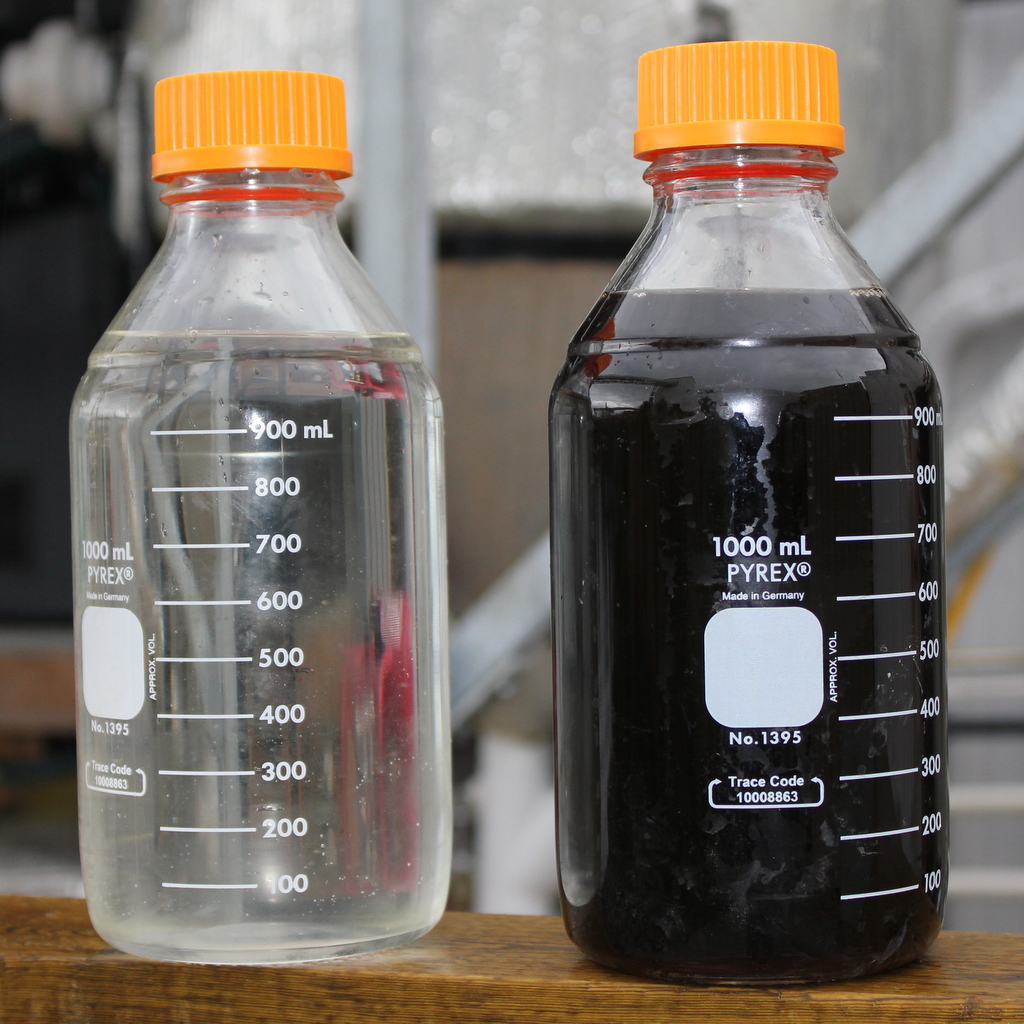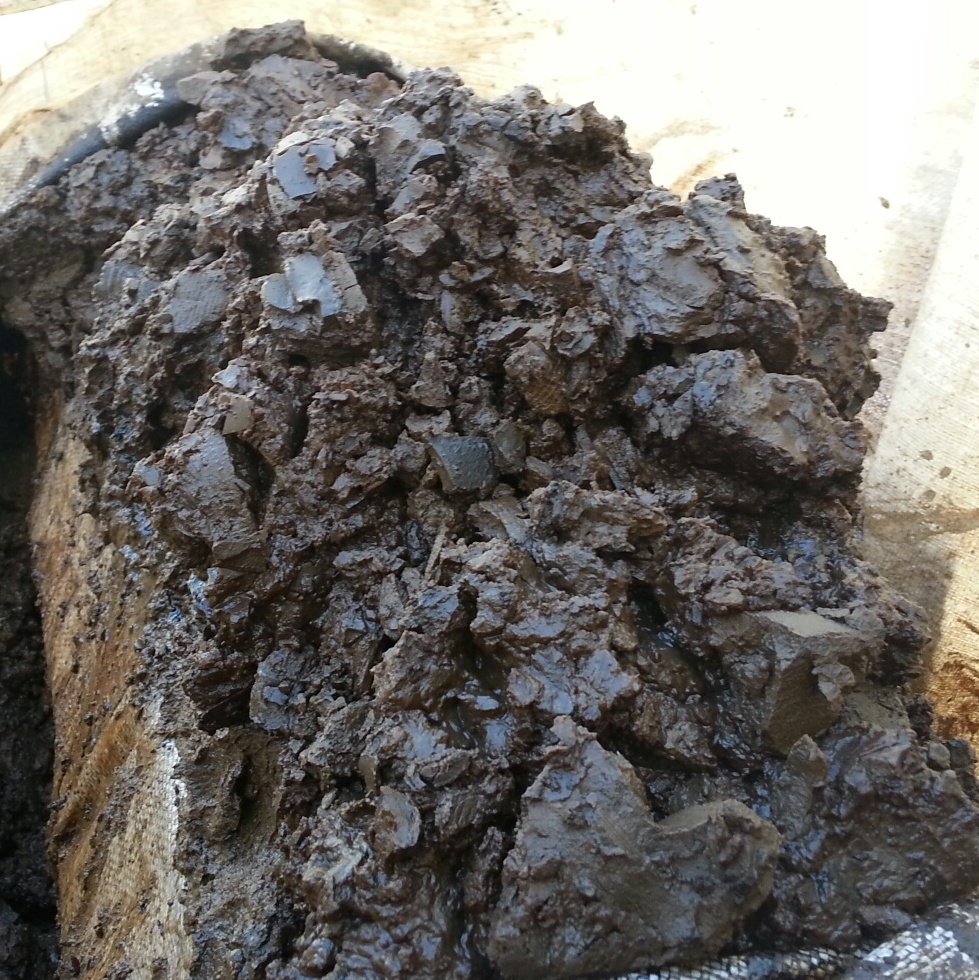Low Grade Heat Driven Produced Water Treatment
Lead Proponent: Saltworks Technologies Inc.
Location: Vancouver, BC
ecoEII Contribution: $ 3 M
Project Total: $ 5.78 M
Project Background

Samples of dark, almost-black evaporator blowdown before being processed by 0.1 m3/day SaltMaker (right) and the resulting clear SaltMaker freshwater with total dissolved solids <200mg/L after being processed (left)
Steam assisted gravity drainage (SAGD) uses injected steam to reduce bitumen viscosity and increase oil production. SAGD generates produced water alongside oil production, with the water recycled as much as possible before “blowdown” is required. Blowdown purges dissolved solids and organics from the SAGD water balance so they do not accumulate. The resulting “blowdown water” consists of water, salt, silica and clay. The vast majority of SAGD operators dispose of blowdown waters in deep wells and withdraw aquifer water to make up the loss. Increasingly, operators must truck their blowdown water to the wells, resulting in higher operating costs. Blowdown management can be the second largest cost of production, after natural gas for steam generation.
Companies are investing in innovative ways to improve blowdown water treatment. Saltworks is one such company, who was awarded $3M from ecoEII for their project “Low Grade Heat Driven Produced Water Treatment“. The Project would develop and test a low energy technology for treating highly impaired waters in the Canadian oil sands industry. The SaltMaker technology is a low temperature crystallizer designed for severe scaling service with automated self-cleaning. The SaltMaker operates on a multiple effect humidification‐dehumidification principle, producing freshwater and solid salts from oil sands wastewater.
Results

Sample of SaltMaker solids produced from treating evaporator blowdown in the SaltMaker
A 0.1 m3/day multiple effect SaltMaker prototype was developed at Saltworks’ facilities, where the first two effects concentrate the source water and the last effect would produce solids and reject the heat. The 0.1 m3/day prototype was first tested on 3,500L of seawater. The prototype operated for 800 hours, producing freshwater and solid salts. The 0.1 m3/day unit was then tested with 3,200L of Once Through Steam Generator (OTSG) blowdown water. The unit operated for 1800 hours and produced freshwater with total dissolved solids (TDS) <200 mg/L. Upon completion of the test, there were no visible signs of scale build up or plugging of the various components. Nonetheless, the unit was cleaned thoroughly. Finally, the 0.1 m3/day SaltMaker prototype was tested with 450L of evaporator blowdown water. The unit successfully and reliably produced freshwater and solids.
The next phase of the project involved scaling-up the prototype to a 10 m3/day SAGD SaltMaker pre‐demonstration plant at Saltworks’ facilities. The plant was first put into operation with seawater. A total of 28,000L of SAGD evaporator blowdown water was then processed through the plant. The test results showed that the SaltMaker pre‐demonstration plant reliably operated with 80oC heat 24-7 and consistently produced freshwater suitable for reuse in SAGD facilities and low volume solids suitable for disposal at Class II landfills.

Completed 10m3/day SaltMaker used to process blowdown water, and produce freshwater suitable for reuse and low volume solids suitable for disposal at Class II landfills
Additional work in the third phase was driven by SAGD operator feedback. As such, a prototype Salt Extractor was developed and tested on 8,000L of evaporator blowdown. Lessons learned during the testing of the Salt Extractor and previous SaltMaker prototypes were incorporated into the design of a 0.3 m3/day fully integrated SaltMaker pilot plant at Saltworks’ facilities. The plant was commissioned on seawater and then tested with a total 20,000L of evaporator blowdown.
The final step in the pre-commercialization of the SaltMaker involved the installation, commissioning and operation of a pilot plant at a SAGD facility in Alberta. A mobile SaltMaker pilot plant was developed and move to the SAGD facility in November 2014. In January 15, 2015 the plant commenced operation. For 60 days thereafter (until March 15, 2015), it processed 6,633L of evaporator blowdown under winter conditions, producing freshwater for re‐use and solids for Class II non‐hazardous landfill disposal.
Benefits to Canada
Use of waste heat for the purposes of recycling wastewater and decreasing waste volume reduces the carbon footprint of SAGD sites in Canada. A reduction in energy and transportation costs associated with waste disposal also benefits the industry as a whole.
Next Steps
Planning and development of a 100 m3/day pre‐demonstration SaltMaker at Saltworks’ facilities was initiated as part of the Project add-on. All parties involved plan on continuing with the implementation of the 100 m3/day SaltMaker.
Page details
- Date modified: